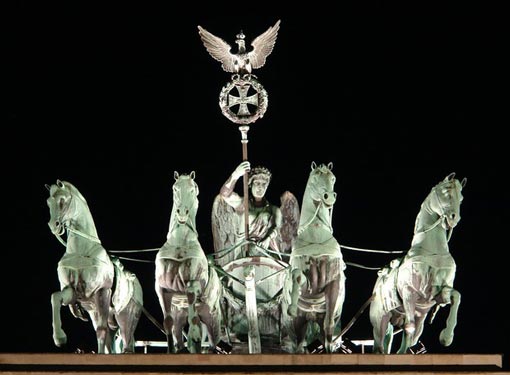Artist:
Johann-Gottfried Schadow
Title:
Quadriga, Brandenburger Tor
Year:
1790
Adress:
Pariser Platz, Brandenburger Tor
www.britannica.com:
The gate is decorated with reliefs and sculptures designed by Gottfried Schadow, the majority of them based on the exploits of Heracles. In 1793 a quadriga statue depicting the goddess of victory bearing a symbol of peace was added.
www.cyark.org:
Completed in 1791 by architect Carl Gotthard Langhans and sculptor Johann Gottfried Schadow, Brandenburg Gate was a Neoclassical masterpiece that immediately became one of the most recognizable structure in Berlin. Its imagery combined representations of peace with classical allusions to famous victories, suggesting that Prussia’s peace rested on its successful military conquests under the leadership of its king.
www.history.com:
Brandenburg Gate: A Brief History
On Wednesday, Barack Obama became the fourth U.S. president to deliver a speech near Berlin’s famed Brandenburg Gate, following in the steps of John F. Kennedy, Ronald Reagan and Bill Clinton. The Brandenburg Gate, an 18th century triumphal arch that has become one of the most recognizable landmarks in Europe, has played witness to some of the most significant moments in modern history. From political speeches set against the backdrop of a divided city, to its role in the emotional reunification of a nation, here’s a look back at some key moments in the history of the Brandenburg Gate. October 1806: Napoleon steals a statue.
www.wikipedia.org:
Johann Gottfried Schadow (20 May 1764 – 27 January 1850) was a German Prussian sculptor.
His most iconic work is the chariot on top of the Brandenburg Gate in Berlin, executed in 1793 when he was still only 29.
Schadow was born in Berlin, where his father was a poor tailor.
His first teacher was the sculptor Tassaert, patronized by Frederick the Great; the master offered his daughter in marriage, but the pupil preferred to elope with a Jewish girl, Marianne Devidel, to Vienna, and the father-in-law not only condoned the offence but furnished money wherewith to visit Italy.[2] Three years' study in Rome formed his style, and in 1788 he returned to Berlin to succeed Tassaert as sculptor to the court and secretary to the Prussian Academy of Arts. Over half a century he produced upwards of two hundred works, varied in style as in subjects.
Among his ambitious efforts are Frederick the Great in Stettin, Blücher in Rostock and Luther in Wittenberg. His portrait statues include Frederick the Great playing the flute, and the crown-princess Louise and her sister Frederica. His busts, of which there are more than one hundred, include seventeen colossal heads in the Walhalla, Ratisbon; Goethe, Wieland, and Fichte were modelled from life.
The gate is decorated with reliefs and sculptures designed by Gottfried Schadow, the majority of them based on the exploits of Heracles. In 1793 a quadriga statue depicting the goddess of victory bearing a symbol of peace was added.
www.cyark.org:
Completed in 1791 by architect Carl Gotthard Langhans and sculptor Johann Gottfried Schadow, Brandenburg Gate was a Neoclassical masterpiece that immediately became one of the most recognizable structure in Berlin. Its imagery combined representations of peace with classical allusions to famous victories, suggesting that Prussia’s peace rested on its successful military conquests under the leadership of its king.
www.history.com:
Brandenburg Gate: A Brief History
On Wednesday, Barack Obama became the fourth U.S. president to deliver a speech near Berlin’s famed Brandenburg Gate, following in the steps of John F. Kennedy, Ronald Reagan and Bill Clinton. The Brandenburg Gate, an 18th century triumphal arch that has become one of the most recognizable landmarks in Europe, has played witness to some of the most significant moments in modern history. From political speeches set against the backdrop of a divided city, to its role in the emotional reunification of a nation, here’s a look back at some key moments in the history of the Brandenburg Gate. October 1806: Napoleon steals a statue.
www.wikipedia.org:
Johann Gottfried Schadow (20 May 1764 – 27 January 1850) was a German Prussian sculptor.
His most iconic work is the chariot on top of the Brandenburg Gate in Berlin, executed in 1793 when he was still only 29.
Schadow was born in Berlin, where his father was a poor tailor.
His first teacher was the sculptor Tassaert, patronized by Frederick the Great; the master offered his daughter in marriage, but the pupil preferred to elope with a Jewish girl, Marianne Devidel, to Vienna, and the father-in-law not only condoned the offence but furnished money wherewith to visit Italy.[2] Three years' study in Rome formed his style, and in 1788 he returned to Berlin to succeed Tassaert as sculptor to the court and secretary to the Prussian Academy of Arts. Over half a century he produced upwards of two hundred works, varied in style as in subjects.
Among his ambitious efforts are Frederick the Great in Stettin, Blücher in Rostock and Luther in Wittenberg. His portrait statues include Frederick the Great playing the flute, and the crown-princess Louise and her sister Frederica. His busts, of which there are more than one hundred, include seventeen colossal heads in the Walhalla, Ratisbon; Goethe, Wieland, and Fichte were modelled from life.



